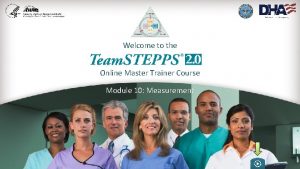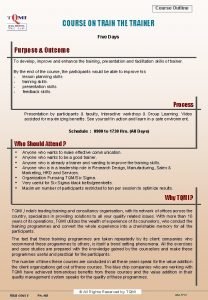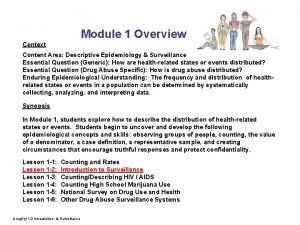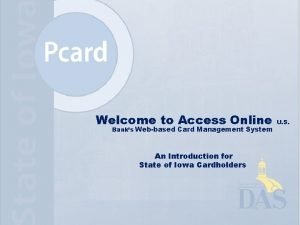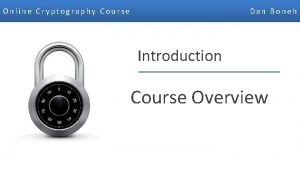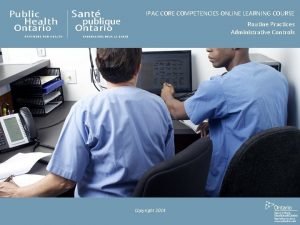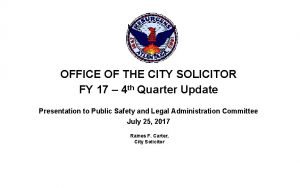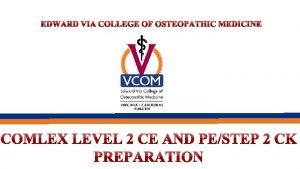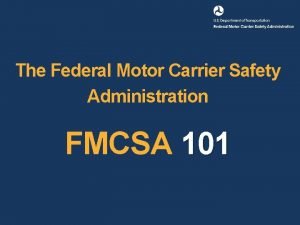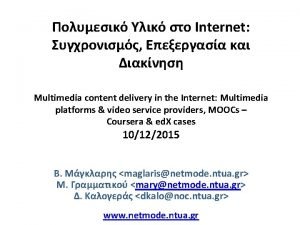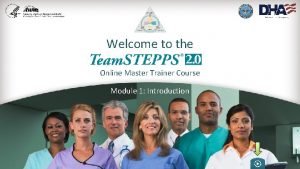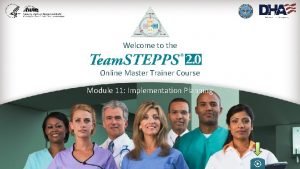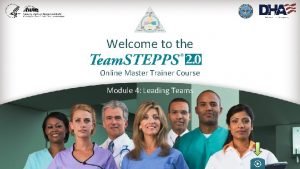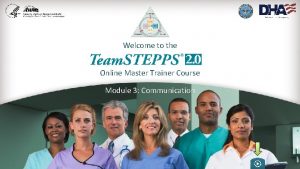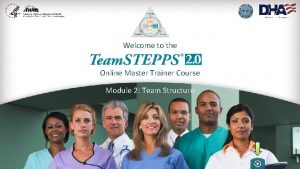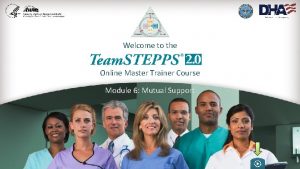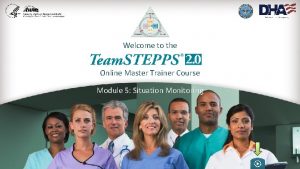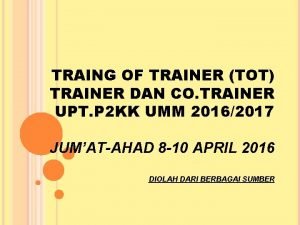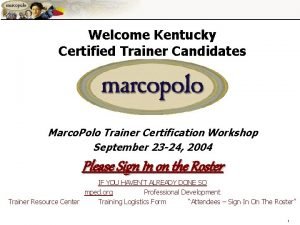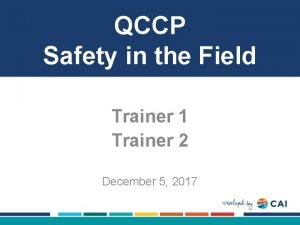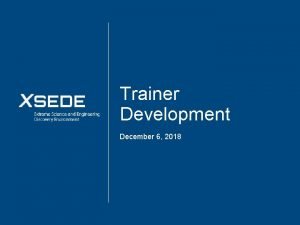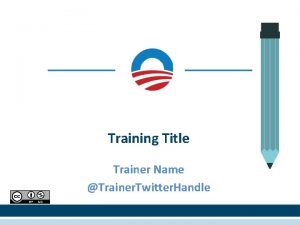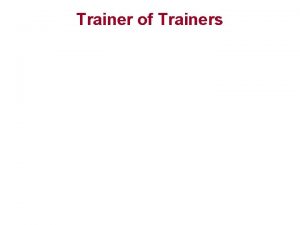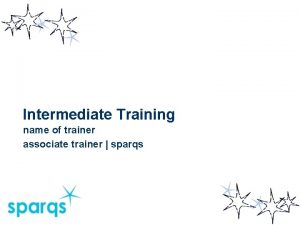Welcome to the Online Master Trainer Course Module






























- Slides: 30

Welcome to the Online Master Trainer Course Module 10: Measurement

How This Online Course Works This online course will walk you through the Team. STEPPS content just as you will present it when you train your colleagues and staff It teaches you all the concepts that comprise the Team. STEPPS initiative While also teaching you to teach Team. STEPPS to your colleagues Use the navigation buttons in the lower right to work through the online modules Select here to move back to the previous slide Module 10: Measurement Select here to move to the next slide 2 of 30

The Materials You Will Use When you deliver your training you will use these materials: • Instructor Manual – Course Management Guide – Instructor guides – Course slides – Measurement tools • Customizable materials • Videos Module 10: Measurement Select here to review materials on the Team. STEPPS website 3 of 30

Please Print the Instructor Guide To best use this online module, please print the Module 10 Instructor Guide, located here Read pages 3 -4 in the guide before we begin Then we will proceed to work through the slides you will use to train – just as if you are delivering this module at your facility. Module 10: Measurement 4 of 30

Additional Resources Additional resources regarding measurement that you may find helpful: • What are the critical success factors for team training in health care? • Evaluating Training Programs: The Four Levels • Twelve best practices for team training evaluation in health care Module 10: Measurement 5 of 30

Slide 2: Objectives You will use slide 2 to introduce the objectives for this module See page 4 in the Instructor Guide for details on how to facilitate this slide Module 10: Measurement 6 of 30

Team. STEPPS Phases: Measurement (Slide 3) Requires Measurement Module 10: Measurement 7 of 30

How to Measure – Kirkpatrick (Slide 4) Level IV – Results Level III – Behavior Level II – Learning Level I – Reactions Module 10: Measurement M U L T I L E V E L A P P R O A C H (Organizational results) (Transfer to the job) (Think, Do, Feel) (Like it and Useful) 8 of 30

Available Measures (Slide 5) Reactions • Course Evaluation Form Learning • Teamwork Attitudes Questionnaire • Learning Benchmarks Behavior • Team Performance Observation Tool • Teamwork Perceptions Questionnaire • AHRQ Surveys on Patient Safety Culture Results • Team Performance Observation Tool • Patient outcome and clinical process measures • Teamwork Perceptions Questionnaire • AHRQ Surveys on Patient Safety Culture Module 10: Measurement • Patient Safety Indicators 9 of 30

Course Evaluation Form (Slide 6) Level I - Reactions Found in Tab F or select image at right to download Provides information about what trainees thought about the training Includes evaluation questions for all available course modules Customizable Module 10: Measurement 10 of 30

Team. STEPPS Teamwork Attitudes Questionnaire (Slide 6) Evaluates Level II - Learning Found in Tab F or select image at right to download 30 -item self-report tool Respondents rate their agreement on a 5 -point scale Measures attitudes toward: • Team Structure • Leadership • Situation Monitoring • Mutual Support • Communication Module 10: Measurement 11 of 30

Learning Benchmarks (Slide 8) Evaluates Level II - Learning Found in Tab F or select image at right to access online A 23 -item multiple-choice test Uses: • To assess knowledge of teamwork • To measure changes in knowledge Caution: • Items tend to be too easy Module 10: Measurement 12 of 30

Team Performance Observation Tool (Slide 9) Level II - Learning and Level III - Behavior Found in Tab F or select image at right to download Tool for observing team performance • Site assessment • Measure training effectiveness Can be adapted to a particular unit Observers should practice using the tool Module 10: Measurement 13 of 30

Team. STEPPS Teamwork Perceptions Questionnaire Evaluates Level II - Learning and Level III - Behavior Found in Tab F or select image at right to download 35 -item self-report tool Respondents rate their agreement on a 5 -point scale Measures staff perceptions of : • Team Structure • Leadership • Situation Monitoring • Mutual Support • Communication Module 10: Measurement 14 of 30

Level III: Behavior (Slide 11) Measure whether information learned during training is transferred to the job Two important factors in transfer are: • Whethere is an opportunity to use the new Team. STEPPS tools or strategies on the job • Whether use of the Team. STEPPS tools and strategies is valued and reinforced Module 10: Measurement 15 of 30

Level III: Behavior: Example Scenario As part of a pediatric ICU’s efforts to improve teamwork within the unit, all nurses are trained on the use of SBAR for presenting patient information to physicians. However, the physician group decides not to attend training. Shortly after implementing the SBAR strategy, a nurse calls the on-call physician about a patient on the unit she is concerned about. She begins to present the patient’s situation and background, but before she can complete her SBAR report, the physician jumps in and says, “Forget that SBAR stuff; just tell me what I need to know!” Take 10 minutes and answer these questions: • Was the use of SBAR valued and reinforced? • What do you think the nurse should do? • Will the nurse use SBAR in the future? • What other factors are important for training transfer to the job? Module 10: Measurement 16 of 30

Example Scenario Debrief You should have noted: • The SBAR was not valued or reinforced by the physician • To ensure Team. STEPPS training transfers to the job, you should: • • Align training objectives with organizational goals Provide organizational support for the training initiative Ensure that frontline care leaders are on board Use measurement to determine the effectiveness of the program When you teach, ask participants these same questions and be sure to include these answers if not mentioned by the participants. Module 10: Measurement 17 of 30

Level III - Behavior: Measures (Slide 12) Team Performance Observation Tool Teamwork Perceptions Questionnaire (T-TPQ) AHRQ Surveys on Patient Safety Culture • We will discuss these surveys in the next section on Level IV - Results Module 10: Measurement 18 of 30

Level IV: Results (Slide 13) Patient Outcome Measures • Examples: Complication rates, infection rates, measurable medication errors, and patient perceptions of care and satisfaction with their care Clinical Process Measures • Examples: Length of patient wait time, time to intubate, medication administration delays, compliance with preventive screenings, number of misdiagnoses, number of structured handoffs used Module 10: Measurement 19 of 30

AHRQ Surveys on Patient Safety Culture (Slide 14) Free, easy-to-use surveys to assess patient safety culture Available for various contexts: • Hospitals • Medical Offices • Nursing Homes • Pharmacies Module 10: Measurement 20 of 30

Hospital Survey on Patient Safety Culture (Slide 15) Level III Behavior and Level IV Results Composed of 51 items and 12 composites Comprehensive instrument that assesses staff perceptions of patient safety culture • Hospital-wide • Specific work area or unit Comparative database • Voluntarily submitted data from U. S. hospitals Module 10: Measurement 21 of 30

Hospital Survey Exercise Please take 5 minutes now and write your answers to the following: • Have you used the Hospital Survey on Patient Safety Culture in your institution? • If so, how did you use the survey results? • What lessons did you learn from the survey? When you teach the Team. STEPPS 2. 0 Master Trainer course, you should discuss these same three questions with your participants Module 10: Measurement 22 of 30

How Can Hospitals Use the Survey? (Slide 16) Raise awareness about patient safety issues Assess patient safety culture Track changes in patient safety culture over time Evaluate the impact of patient safety interventions, such as Team. STEPPS Module 10: Measurement 23 of 30

Survey Measures (Slide 17) Survey Measures: 12 Areas of Patient Safety and Two Overall Items: Unit-level safety areas Hospitalwide safety areas • Frequency of events reported • Hospital management support for patient safety • Supervisor/manager expectations and actions promoting safety • Hospital handoffs and transitions • Overall perceptions of safety • Teamwork across hospital units • Organizational learning—continuous improvement • Teamwork within units • Communication and openness • Feedback and communication about error • Nonpunitive responses to error • Staffing Module 10: Measurement Overall items • The patient safety “grade” respondents would assign their work area/unit • The number of events the respondent reported in the last 12 months 24 of 30

What Support Is Available? (Slide 18) AHRQ Patient Safety Link Hospital Survey Toolkit • Survey forms • Survey items and dimensions • Survey User’s Guide • Survey feedback report template Data entry and analysis tool Comparative database and reports E-mail Questions to: • Safety. Culture. Surveys@westat. com; or • Databases. On. Safety. Culture@westat. com Module 10: Measurement 25 of 30

AHRQ Patient Safety Indicators (PSIs) (Slide 19) Measure Level IV - Results Provide information on potential inhospital complications and adverse events Can help identify potential adverse events that might need further study Include indicators for in-hospital complications that may represent patient safety events Select the image at right to view PSIs on AHRQ’s website Module 10: Measurement 26 of 30

Evaluating Team. STEPPS Exercise (Slide 20) Three nurses and the infection control officer from a 16 -bed postsurgical intensive care unit attend the 2 -day Team. STEPPS Master Training course. During the implementation planning session, the team agrees that hand hygiene compliance has been a major problem, especially physician compliance. As a result, the unit has a relatively high surgical site infection rate. The team decides to use the CUS and Two-Challenge Rule tools as strategies to address this issue. As part of their implementation, they train all the nurses and the employed physician staff on these two tools, but struggle with getting surgeons who are not employed by the hospital to participate. Once the training is complete, they decide to launch the implementation of CUS and the Two-Challenge Rule. Download the Evaluating Team. STEPPS Worksheet Take 15 minutes to review the scenario and answer the four questions Module 10: Measurement 27 of 30

Evaluating Team. STEPPS Exercise: Debrief Let’s Review: • Which measure or measures did you identify? • Why did you choose the identified measures? • What organizational barriers might interfere with successful transfer? See pages 22 and 23 in the Instructor Guide for details on how to facilitate this exercise Module 10: Measurement 28 of 30

Module 10 Summary In this module you learned to: • Describe the importance of measurement • Describe the Kirkpatrick model of training evaluation • Identify measures that can be used to assess the impact of Team. STEPPS • Describe the AHRQ Surveys on Patient Safety Culture • Prepare a plan for determining if Team. STEPPS worked Module 10: Measurement 29 of 30

Module 10 Conclusion This concludes Module 10 of the Team. STEPPS 2. 0 Online Master Trainer Course Module 10 Go to Module 11 Module 10: Measurement 30 of 30
 Teamstepps master trainer
Teamstepps master trainer Master trainer 45
Master trainer 45 Train the trainer objectives
Train the trainer objectives Train the trainer course outline
Train the trainer course outline C device module module 1
C device module module 1 Supervisor safety leadership training
Supervisor safety leadership training Course module sample
Course module sample Welcome welcome this is our christmas story
Welcome welcome this is our christmas story Hello my dear students
Hello my dear students One and half brick wall
One and half brick wall Course number and title
Course number and title Course interne moyenne externe
Course interne moyenne externe Welcome to our online class
Welcome to our online class Welcome to access online
Welcome to access online Welcome to my online class
Welcome to my online class Cryptography online course
Cryptography online course Osocp
Osocp Ipac online course
Ipac online course Online cryptography course
Online cryptography course Jrotc marksmanship instructor course online
Jrotc marksmanship instructor course online Ptit safe driving and awareness course online
Ptit safe driving and awareness course online Comlex pe videos stream
Comlex pe videos stream Medical english online course
Medical english online course Fmcsa north american standard level i course online
Fmcsa north american standard level i course online Jrotc marksmanship instructor course online
Jrotc marksmanship instructor course online Moocs
Moocs Chandler online academy
Chandler online academy American beauty online
American beauty online Hình ảnh bộ gõ cơ thể búng tay
Hình ảnh bộ gõ cơ thể búng tay Frameset trong html5
Frameset trong html5 Bổ thể
Bổ thể
